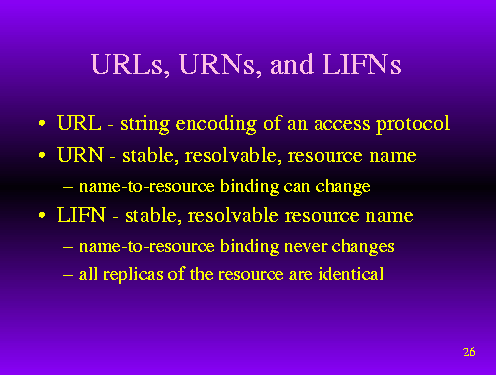
Click slide for next, or goto previous, first, last slides or back to thumbnail layout.
Alphabet soup time...
RCDS deals with three kinds of identifiers: URLs, URNs, and LIFNs.
URLs are what we are all used to dealing with. They are simply an ASCII representation of instructions that tell a client how to retrieve a file from a file server. (URLs can also be used in other ways, but RCDS doesn't concern itself with these.)
URNs are uniform resource names. Unlike URLs, URNs have no notion of either location or protocol wired into them. However, it is possible to ask "the net" to tell you things about them -- including where they are. The process by which this is done is called URN resolution.
Once you assign a URN to a resource, the URN always refers to that resource, even though its acutal location(s), or the protocol used to access it, might have changed. Note that the resource itself may be updated, say, to replace an old version with a newer one.
The idea is that a URN can be stable and usable for tens or even hundreds of years. (Provided, that is, that any copy of that resource or its description still exists after that time!)
LIFNs - location-independent file names -- are much like URNs in that they are location- independent, protocol-independent, stable, and resolvable. However, unlike a URN, a LIFN is constrained to name only a very specific version of a resource -- such that: (a) every copy of a resource named by a LIFNis identical, and (b) once a LIFNis assigned to a resource, the binding between that LIFN and that resource never changes.
Click slide for next, or goto previous, or back to thumbnail layout.